Brand Management: Definition, Evaluation, and Techniques
VerifiedAdded on 2023/06/10
|14
|2491
|238
AI Summary
This presentation discusses brand management, its definition and explanation, ways in which brands are managed collaboratively and in partnership at the domestic and international level, techniques for measuring and managing brand value, and ways to evaluate brand performance. It also includes the advantages and disadvantages of brand management and a case study of Unilever.
Contribute Materials
Your contribution can guide someone’s learning journey. Share your
documents today.

ORGANISATIONAL
BEHAVIOUR
BEHAVIOUR
Secure Best Marks with AI Grader
Need help grading? Try our AI Grader for instant feedback on your assignments.

TABLE OF CONTENTS
INTRODUCTION
MAIN BODY
Definition and explanation of Brand Management
Ways in which brands are managed collaboratively and in partnership at the domestic and international
level.
Ways in which brand’s performance can be evaluated
Techniques for measuring and managing brand value
CONCLUSION
REFERENCES
INTRODUCTION
MAIN BODY
Definition and explanation of Brand Management
Ways in which brands are managed collaboratively and in partnership at the domestic and international
level.
Ways in which brand’s performance can be evaluated
Techniques for measuring and managing brand value
CONCLUSION
REFERENCES
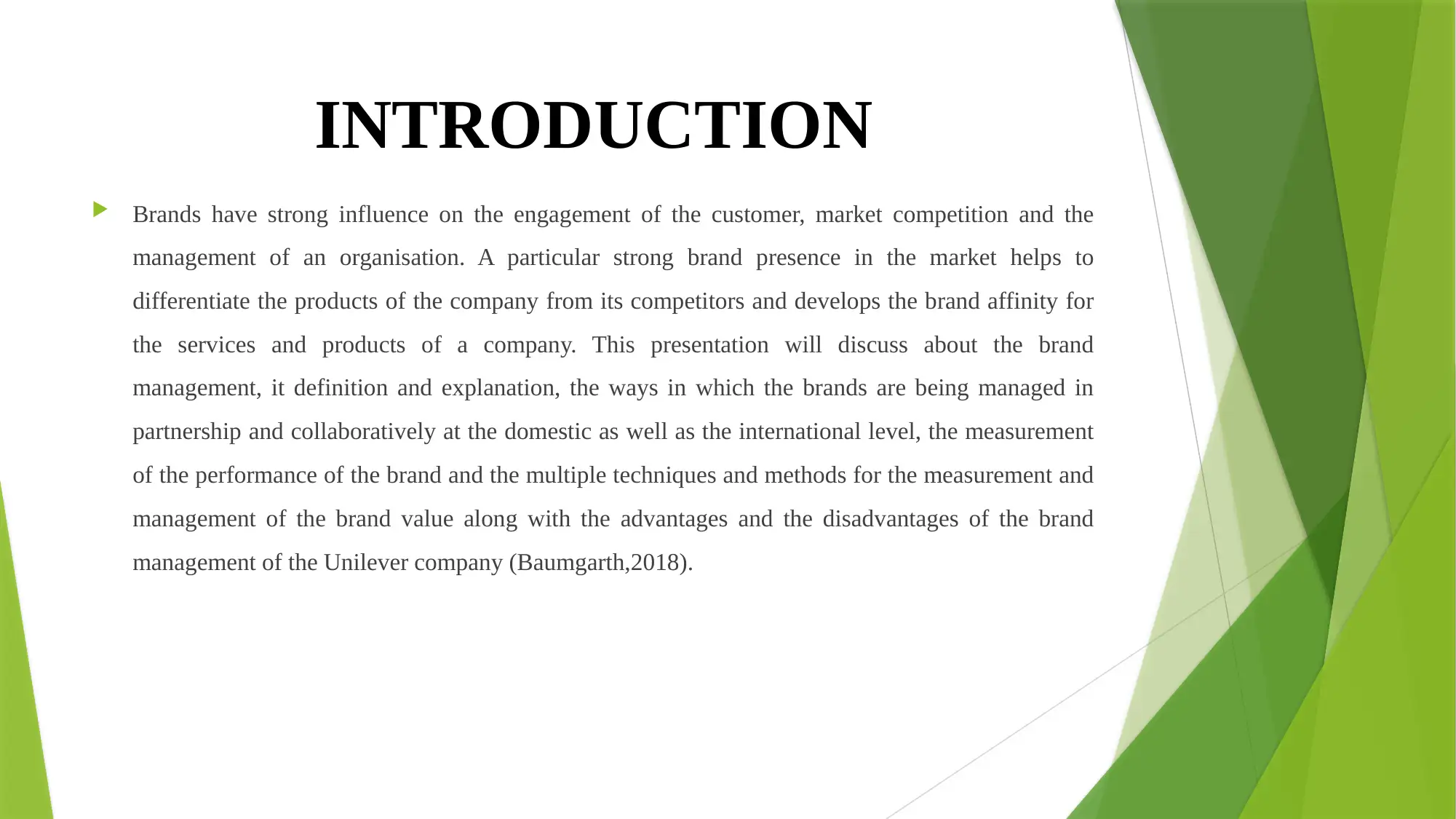
INTRODUCTION
Brands have strong influence on the engagement of the customer, market competition and the
management of an organisation. A particular strong brand presence in the market helps to
differentiate the products of the company from its competitors and develops the brand affinity for
the services and products of a company. This presentation will discuss about the brand
management, it definition and explanation, the ways in which the brands are being managed in
partnership and collaboratively at the domestic as well as the international level, the measurement
of the performance of the brand and the multiple techniques and methods for the measurement and
management of the brand value along with the advantages and the disadvantages of the brand
management of the Unilever company (Baumgarth,2018).
Brands have strong influence on the engagement of the customer, market competition and the
management of an organisation. A particular strong brand presence in the market helps to
differentiate the products of the company from its competitors and develops the brand affinity for
the services and products of a company. This presentation will discuss about the brand
management, it definition and explanation, the ways in which the brands are being managed in
partnership and collaboratively at the domestic as well as the international level, the measurement
of the performance of the brand and the multiple techniques and methods for the measurement and
management of the brand value along with the advantages and the disadvantages of the brand
management of the Unilever company (Baumgarth,2018).
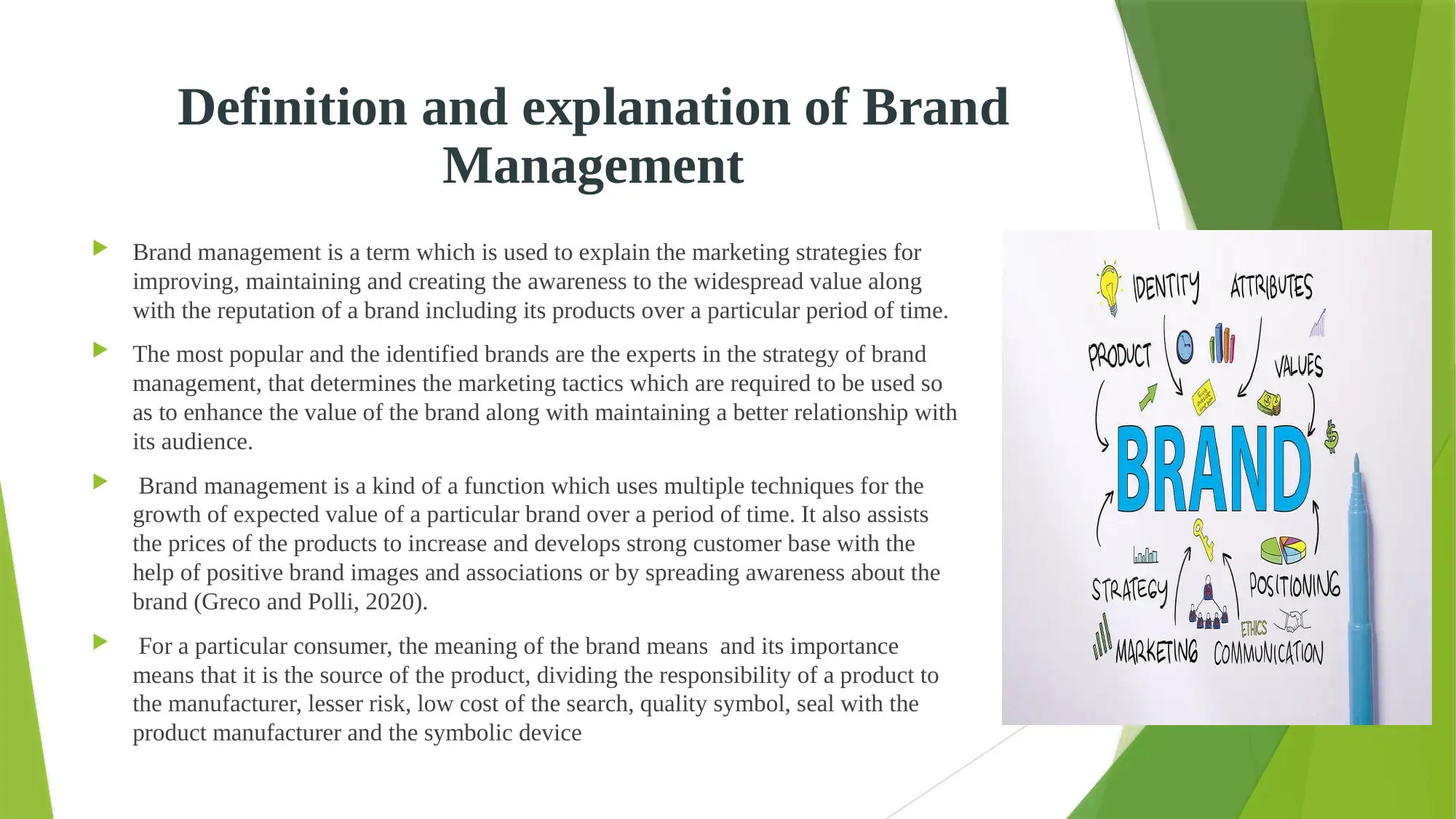
Definition and explanation of Brand
Management
Brand management is a term which is used to explain the marketing strategies for
improving, maintaining and creating the awareness to the widespread value along
with the reputation of a brand including its products over a particular period of time.
The most popular and the identified brands are the experts in the strategy of brand
management, that determines the marketing tactics which are required to be used so
as to enhance the value of the brand along with maintaining a better relationship with
its audience.
Brand management is a kind of a function which uses multiple techniques for the
growth of expected value of a particular brand over a period of time. It also assists
the prices of the products to increase and develops strong customer base with the
help of positive brand images and associations or by spreading awareness about the
brand (Greco and Polli, 2020).
For a particular consumer, the meaning of the brand means and its importance
means that it is the source of the product, dividing the responsibility of a product to
the manufacturer, lesser risk, low cost of the search, quality symbol, seal with the
product manufacturer and the symbolic device
Management
Brand management is a term which is used to explain the marketing strategies for
improving, maintaining and creating the awareness to the widespread value along
with the reputation of a brand including its products over a particular period of time.
The most popular and the identified brands are the experts in the strategy of brand
management, that determines the marketing tactics which are required to be used so
as to enhance the value of the brand along with maintaining a better relationship with
its audience.
Brand management is a kind of a function which uses multiple techniques for the
growth of expected value of a particular brand over a period of time. It also assists
the prices of the products to increase and develops strong customer base with the
help of positive brand images and associations or by spreading awareness about the
brand (Greco and Polli, 2020).
For a particular consumer, the meaning of the brand means and its importance
means that it is the source of the product, dividing the responsibility of a product to
the manufacturer, lesser risk, low cost of the search, quality symbol, seal with the
product manufacturer and the symbolic device
Secure Best Marks with AI Grader
Need help grading? Try our AI Grader for instant feedback on your assignments.
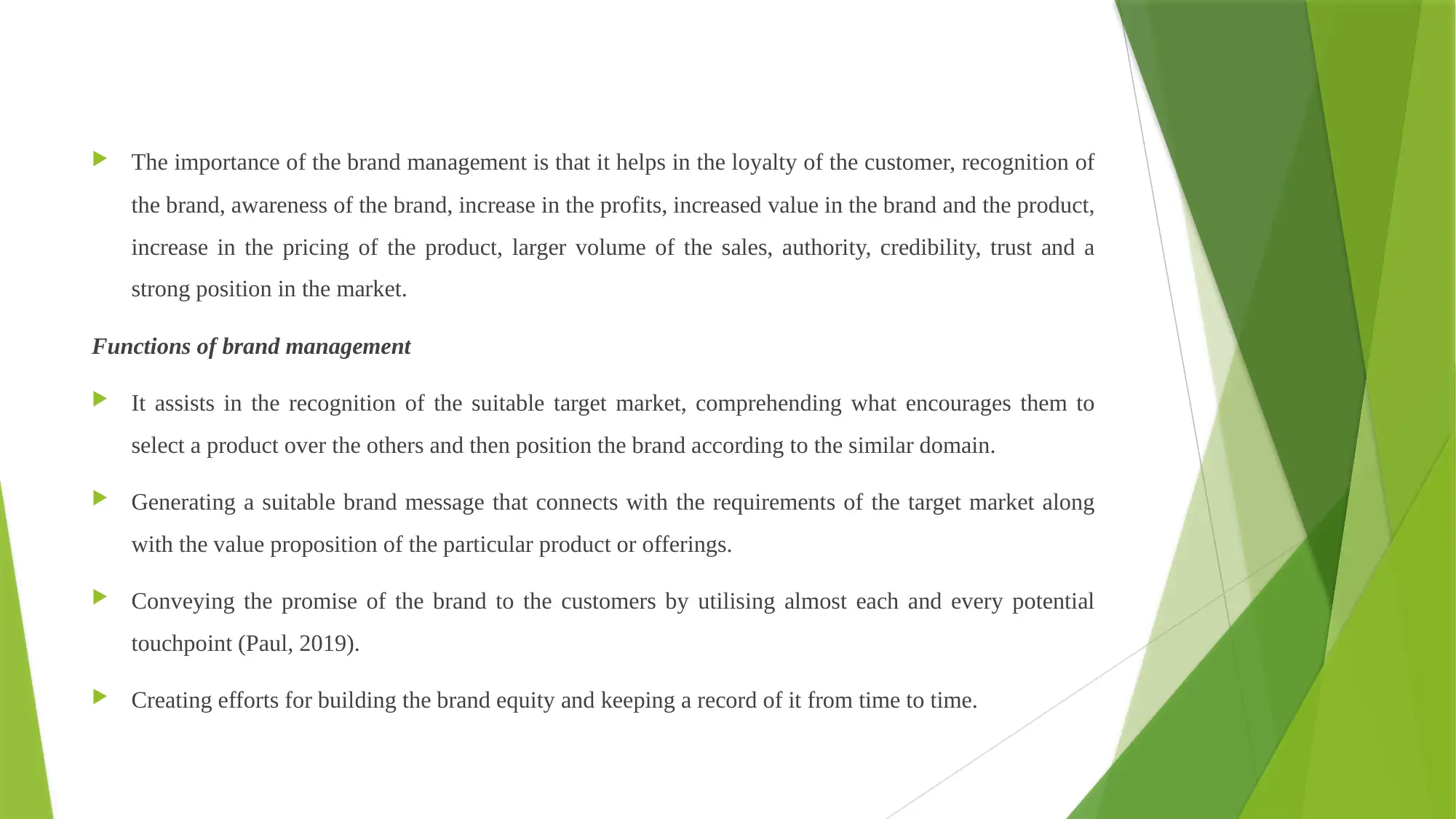
The importance of the brand management is that it helps in the loyalty of the customer, recognition of
the brand, awareness of the brand, increase in the profits, increased value in the brand and the product,
increase in the pricing of the product, larger volume of the sales, authority, credibility, trust and a
strong position in the market.
Functions of brand management
It assists in the recognition of the suitable target market, comprehending what encourages them to
select a product over the others and then position the brand according to the similar domain.
Generating a suitable brand message that connects with the requirements of the target market along
with the value proposition of the particular product or offerings.
Conveying the promise of the brand to the customers by utilising almost each and every potential
touchpoint (Paul, 2019).
Creating efforts for building the brand equity and keeping a record of it from time to time.
the brand, awareness of the brand, increase in the profits, increased value in the brand and the product,
increase in the pricing of the product, larger volume of the sales, authority, credibility, trust and a
strong position in the market.
Functions of brand management
It assists in the recognition of the suitable target market, comprehending what encourages them to
select a product over the others and then position the brand according to the similar domain.
Generating a suitable brand message that connects with the requirements of the target market along
with the value proposition of the particular product or offerings.
Conveying the promise of the brand to the customers by utilising almost each and every potential
touchpoint (Paul, 2019).
Creating efforts for building the brand equity and keeping a record of it from time to time.

Evaluating how brands are managed collaboratively and
in partnership, both at a domestic and international level
For purpose of managing brands collaboratively, organizations may utilize a
strategic approach such as mutual alliance.
According to this strategy, firm may take approach to make a legal agreement that
help to collaborate with each other in professional manner.
Along with that, companies may take initiative to utilize joint venture and strategic
partnership approaches, which enable them to manage brands in partnership, either
national or international level.
At domestic level, firm try to examinee best method including joint venture ship,
firm try to collaboratively work together to capture the market.
in partnership, both at a domestic and international level
For purpose of managing brands collaboratively, organizations may utilize a
strategic approach such as mutual alliance.
According to this strategy, firm may take approach to make a legal agreement that
help to collaborate with each other in professional manner.
Along with that, companies may take initiative to utilize joint venture and strategic
partnership approaches, which enable them to manage brands in partnership, either
national or international level.
At domestic level, firm try to examinee best method including joint venture ship,
firm try to collaboratively work together to capture the market.

Evaluating how brands are managed collaboratively
and in partnership, both at a domestic
and international level
At the international level
Management of the brands overtime
As the existing business environment is very inter-connected, complex and challenging the brands are getting
affected by the increased competition, rules and regulations, manufacturing costs, issues of the distribution along
with the supply chain while also needing the constant advocacy and the reputed management.
Being flexible and adaptive
Brand management is not about the strict implementation of the rules, practices and the frameworks rather the
successful brands at the international levels are being managed by the regular brand guardrails along with the
freedom to adjust to the leverage local opportunities of growth (Mills and Robson, 2019).
Leveraging the technology
There exists various technology based solutions that has altered the practice of the management of the brand. The
forward thinking have recognised the advantages and the scalability of the advancement in the technology in the
field of brand management and have also acquired to the solutions fastly. The Customer Relationship Management
(CRM), recognises the activation and the licensing systems that have experienced the fast advances in the field of
technological innovations and the scalability at the global level (Keller and Swaminathan, 2020).
Using the custodians
Making sure the consistency in the field of marketing, strategy, brand identity and the activations must be the main
function and responsibility of at least a single person in the firm.
and in partnership, both at a domestic
and international level
At the international level
Management of the brands overtime
As the existing business environment is very inter-connected, complex and challenging the brands are getting
affected by the increased competition, rules and regulations, manufacturing costs, issues of the distribution along
with the supply chain while also needing the constant advocacy and the reputed management.
Being flexible and adaptive
Brand management is not about the strict implementation of the rules, practices and the frameworks rather the
successful brands at the international levels are being managed by the regular brand guardrails along with the
freedom to adjust to the leverage local opportunities of growth (Mills and Robson, 2019).
Leveraging the technology
There exists various technology based solutions that has altered the practice of the management of the brand. The
forward thinking have recognised the advantages and the scalability of the advancement in the technology in the
field of brand management and have also acquired to the solutions fastly. The Customer Relationship Management
(CRM), recognises the activation and the licensing systems that have experienced the fast advances in the field of
technological innovations and the scalability at the global level (Keller and Swaminathan, 2020).
Using the custodians
Making sure the consistency in the field of marketing, strategy, brand identity and the activations must be the main
function and responsibility of at least a single person in the firm.
Paraphrase This Document
Need a fresh take? Get an instant paraphrase of this document with our AI Paraphraser

At the domestic level
Using the power of consumers
The collaborative marketing is more than just collaborating with other
firms. The advances modern technology offers us improved outreach to
acquire the voice of the target market which assists in the development
of the use of the social media.
Fulfilling the goals of the campaigns
Using the collaborations to cover the weaknesses and the shortcomings
in a strategic manner. The organisation that have the same kind of the
target audience, marketing campaigns and the goals will be relatable to
each other (Pamfilie and Croitoru, 2018).
Using the power of consumers
The collaborative marketing is more than just collaborating with other
firms. The advances modern technology offers us improved outreach to
acquire the voice of the target market which assists in the development
of the use of the social media.
Fulfilling the goals of the campaigns
Using the collaborations to cover the weaknesses and the shortcomings
in a strategic manner. The organisation that have the same kind of the
target audience, marketing campaigns and the goals will be relatable to
each other (Pamfilie and Croitoru, 2018).
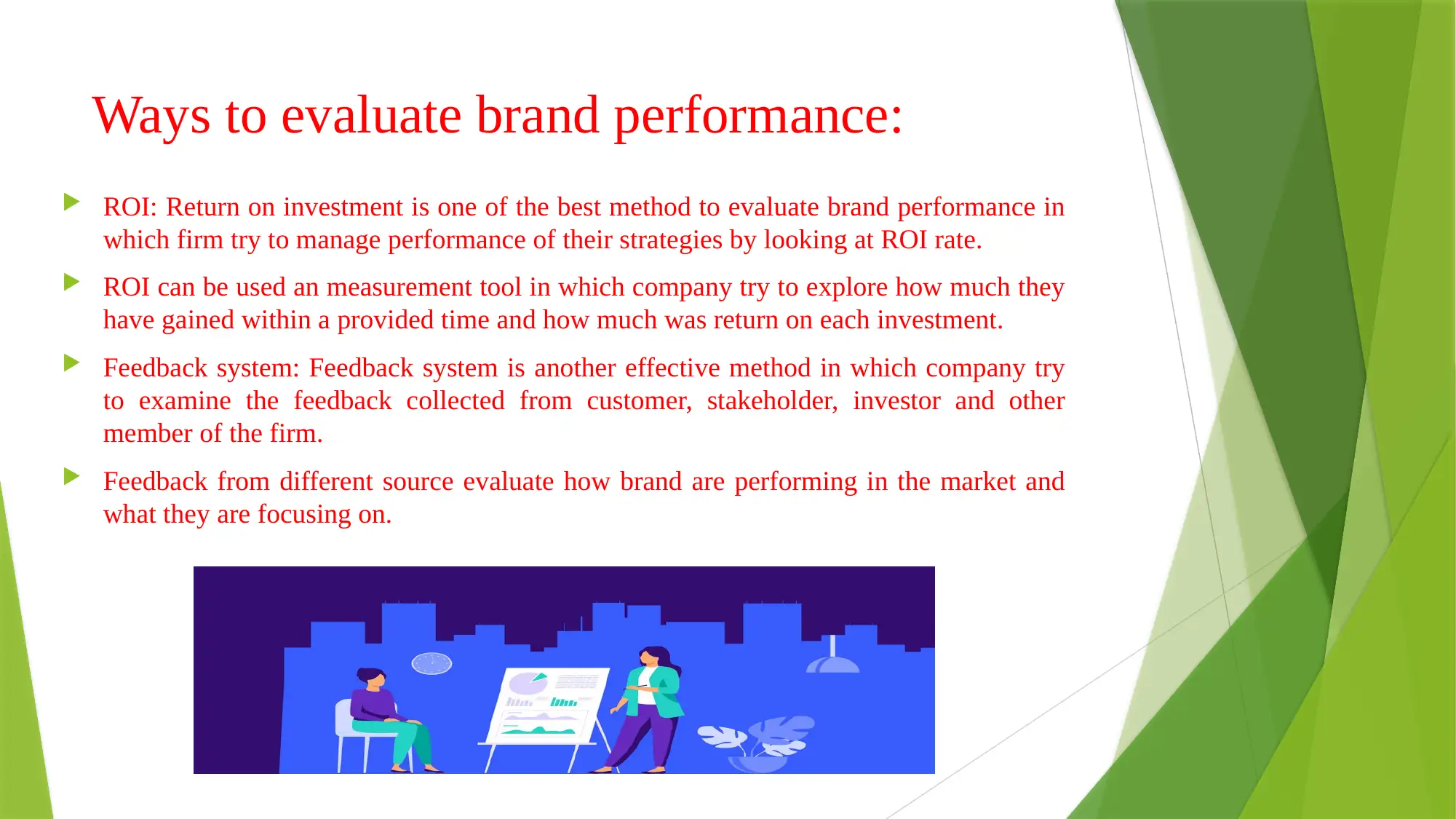
Ways to evaluate brand performance:
ROI: Return on investment is one of the best method to evaluate brand performance in
which firm try to manage performance of their strategies by looking at ROI rate.
ROI can be used an measurement tool in which company try to explore how much they
have gained within a provided time and how much was return on each investment.
Feedback system: Feedback system is another effective method in which company try
to examine the feedback collected from customer, stakeholder, investor and other
member of the firm.
Feedback from different source evaluate how brand are performing in the market and
what they are focusing on.
ROI: Return on investment is one of the best method to evaluate brand performance in
which firm try to manage performance of their strategies by looking at ROI rate.
ROI can be used an measurement tool in which company try to explore how much they
have gained within a provided time and how much was return on each investment.
Feedback system: Feedback system is another effective method in which company try
to examine the feedback collected from customer, stakeholder, investor and other
member of the firm.
Feedback from different source evaluate how brand are performing in the market and
what they are focusing on.
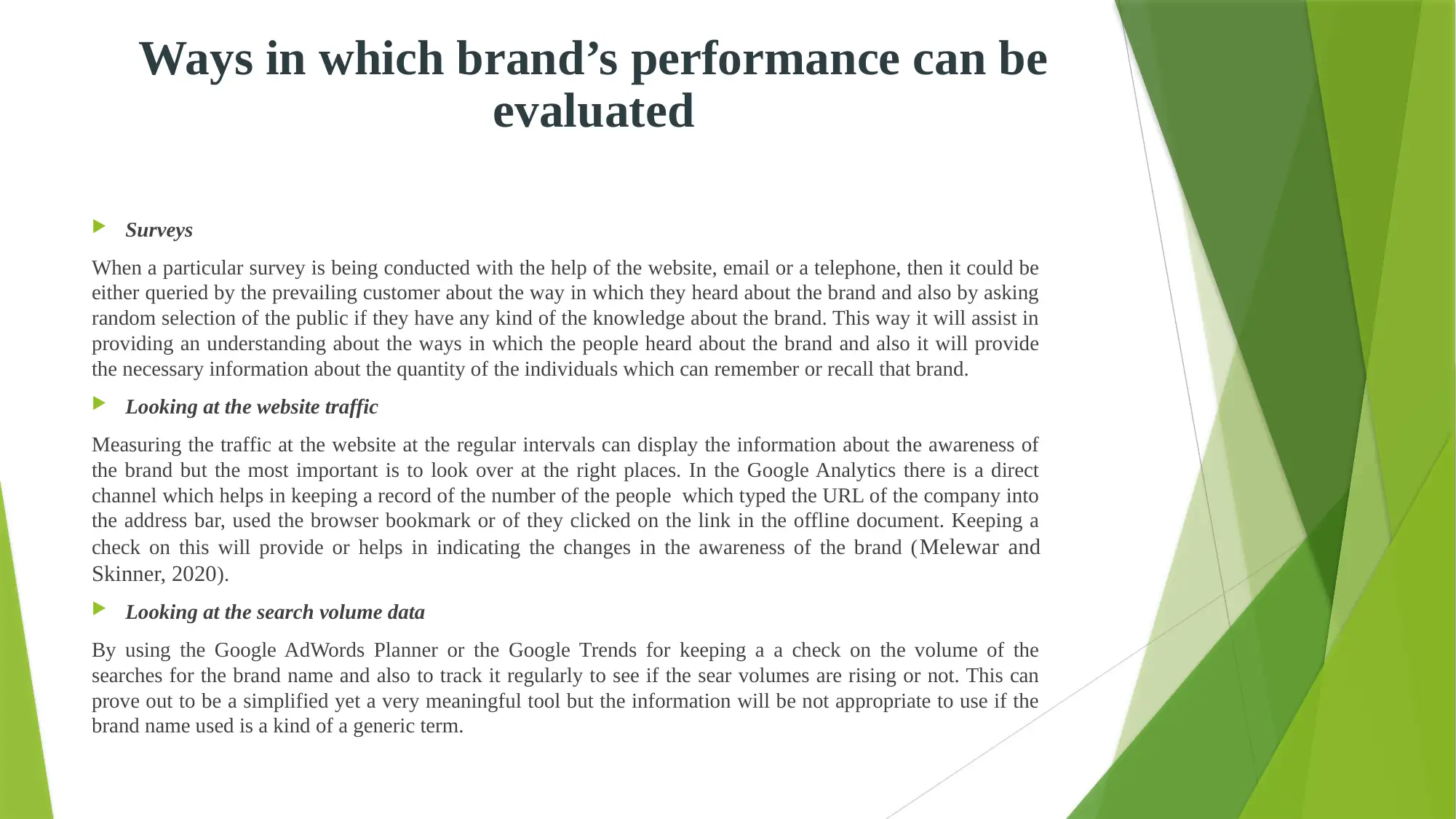
Ways in which brand’s performance can be
evaluated
Surveys
When a particular survey is being conducted with the help of the website, email or a telephone, then it could be
either queried by the prevailing customer about the way in which they heard about the brand and also by asking
random selection of the public if they have any kind of the knowledge about the brand. This way it will assist in
providing an understanding about the ways in which the people heard about the brand and also it will provide
the necessary information about the quantity of the individuals which can remember or recall that brand.
Looking at the website traffic
Measuring the traffic at the website at the regular intervals can display the information about the awareness of
the brand but the most important is to look over at the right places. In the Google Analytics there is a direct
channel which helps in keeping a record of the number of the people which typed the URL of the company into
the address bar, used the browser bookmark or of they clicked on the link in the offline document. Keeping a
check on this will provide or helps in indicating the changes in the awareness of the brand (Melewar and
Skinner, 2020).
Looking at the search volume data
By using the Google AdWords Planner or the Google Trends for keeping a a check on the volume of the
searches for the brand name and also to track it regularly to see if the sear volumes are rising or not. This can
prove out to be a simplified yet a very meaningful tool but the information will be not appropriate to use if the
brand name used is a kind of a generic term.
evaluated
Surveys
When a particular survey is being conducted with the help of the website, email or a telephone, then it could be
either queried by the prevailing customer about the way in which they heard about the brand and also by asking
random selection of the public if they have any kind of the knowledge about the brand. This way it will assist in
providing an understanding about the ways in which the people heard about the brand and also it will provide
the necessary information about the quantity of the individuals which can remember or recall that brand.
Looking at the website traffic
Measuring the traffic at the website at the regular intervals can display the information about the awareness of
the brand but the most important is to look over at the right places. In the Google Analytics there is a direct
channel which helps in keeping a record of the number of the people which typed the URL of the company into
the address bar, used the browser bookmark or of they clicked on the link in the offline document. Keeping a
check on this will provide or helps in indicating the changes in the awareness of the brand (Melewar and
Skinner, 2020).
Looking at the search volume data
By using the Google AdWords Planner or the Google Trends for keeping a a check on the volume of the
searches for the brand name and also to track it regularly to see if the sear volumes are rising or not. This can
prove out to be a simplified yet a very meaningful tool but the information will be not appropriate to use if the
brand name used is a kind of a generic term.
Secure Best Marks with AI Grader
Need help grading? Try our AI Grader for instant feedback on your assignments.

Techniques for measuring and managing
brand value
Cost based valuation
This particular method helps in calculating the value of the brand and also calculates the amount needed to build the brand. From
the beginning, all the expenses which are being incurred in building the brand are added such as the contacts with the branding
agencies, trademarks, promotions, marketing and the salaries of the employees who emphasize on the brand.
This method is less reliable as it needs particular assumptions and the benefit is that valuing the multiple elements of
the real estate is assisting when tackling with the property which is new or is different from others in distinct ways (Miliopoulou.,
2021).
Market based valuation
This kind of the method calculates the value of the brand on the basis of the existing climate of the market. The market based
valuation can be calculated easily by looking over at the sale price of the same kind of the brands. It can also be done by looking
at the stock performance, valuation or by querying the leaders in other firms about how much amount they would pay for the
brand. The benefit of this approach is that it do not need any kind of a review of the financial documentation and it has a
considerable room for the errors. The disadvantage of this is that there is a lack of the available information (Marland and
DeCillia, 2020).
Income based valuation
This method can be implemented by looking at the income developed by the brand at the current time. For instance, how much
money the brand is bringing into the company. This acquires some kind of the discernment as it is required to look at the financial
matters of the firms. After that, the parts that can contribute directly to the awareness and the reputation acquired by the brand
must be examined. Advantage of this method is that it uses the free cash flow for both the approaches and the disadvantage is that
brand value
Cost based valuation
This particular method helps in calculating the value of the brand and also calculates the amount needed to build the brand. From
the beginning, all the expenses which are being incurred in building the brand are added such as the contacts with the branding
agencies, trademarks, promotions, marketing and the salaries of the employees who emphasize on the brand.
This method is less reliable as it needs particular assumptions and the benefit is that valuing the multiple elements of
the real estate is assisting when tackling with the property which is new or is different from others in distinct ways (Miliopoulou.,
2021).
Market based valuation
This kind of the method calculates the value of the brand on the basis of the existing climate of the market. The market based
valuation can be calculated easily by looking over at the sale price of the same kind of the brands. It can also be done by looking
at the stock performance, valuation or by querying the leaders in other firms about how much amount they would pay for the
brand. The benefit of this approach is that it do not need any kind of a review of the financial documentation and it has a
considerable room for the errors. The disadvantage of this is that there is a lack of the available information (Marland and
DeCillia, 2020).
Income based valuation
This method can be implemented by looking at the income developed by the brand at the current time. For instance, how much
money the brand is bringing into the company. This acquires some kind of the discernment as it is required to look at the financial
matters of the firms. After that, the parts that can contribute directly to the awareness and the reputation acquired by the brand
must be examined. Advantage of this method is that it uses the free cash flow for both the approaches and the disadvantage is that
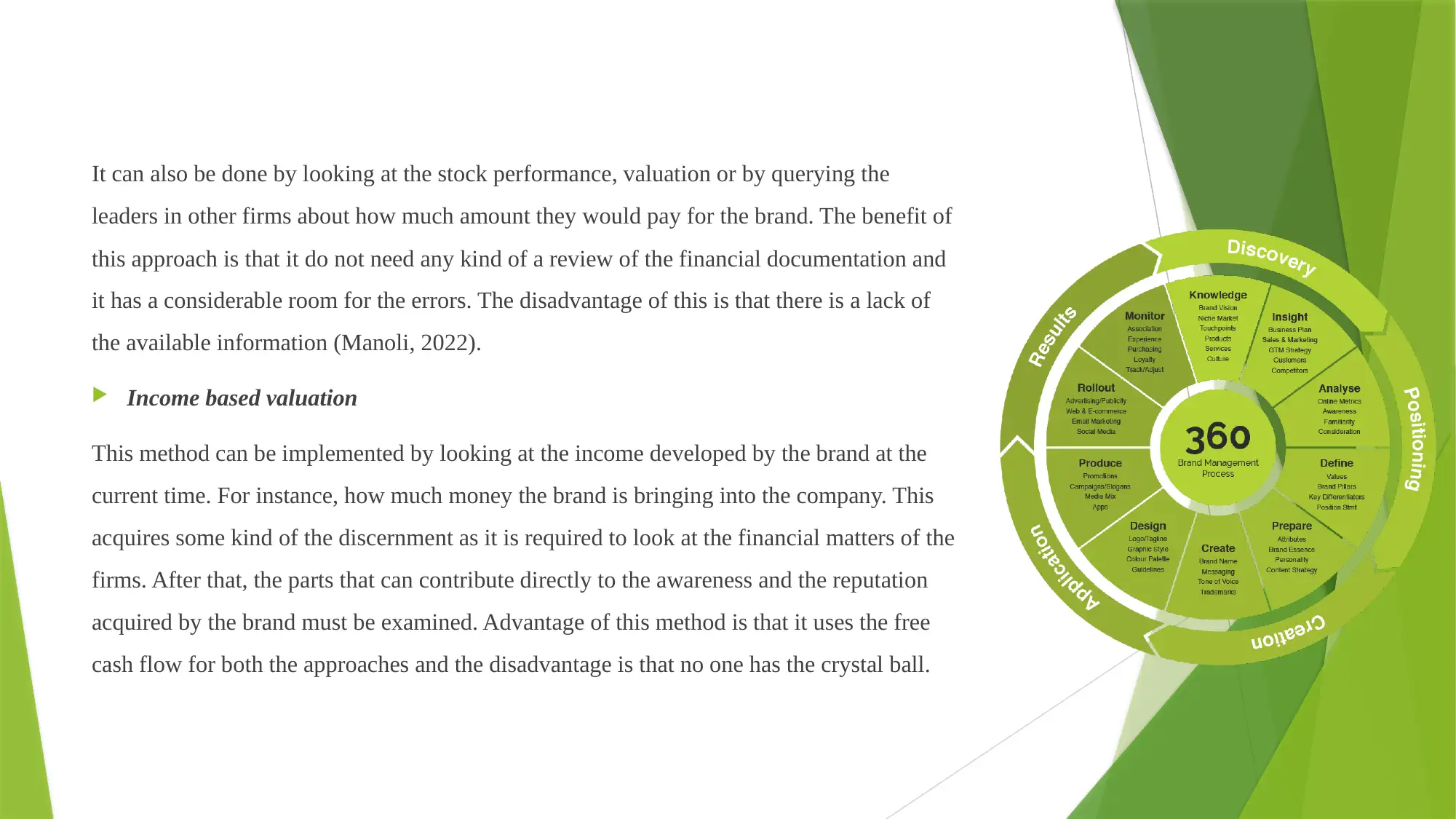
It can also be done by looking at the stock performance, valuation or by querying the
leaders in other firms about how much amount they would pay for the brand. The benefit of
this approach is that it do not need any kind of a review of the financial documentation and
it has a considerable room for the errors. The disadvantage of this is that there is a lack of
the available information (Manoli, 2022).
Income based valuation
This method can be implemented by looking at the income developed by the brand at the
current time. For instance, how much money the brand is bringing into the company. This
acquires some kind of the discernment as it is required to look at the financial matters of the
firms. After that, the parts that can contribute directly to the awareness and the reputation
acquired by the brand must be examined. Advantage of this method is that it uses the free
cash flow for both the approaches and the disadvantage is that no one has the crystal ball.
leaders in other firms about how much amount they would pay for the brand. The benefit of
this approach is that it do not need any kind of a review of the financial documentation and
it has a considerable room for the errors. The disadvantage of this is that there is a lack of
the available information (Manoli, 2022).
Income based valuation
This method can be implemented by looking at the income developed by the brand at the
current time. For instance, how much money the brand is bringing into the company. This
acquires some kind of the discernment as it is required to look at the financial matters of the
firms. After that, the parts that can contribute directly to the awareness and the reputation
acquired by the brand must be examined. Advantage of this method is that it uses the free
cash flow for both the approaches and the disadvantage is that no one has the crystal ball.
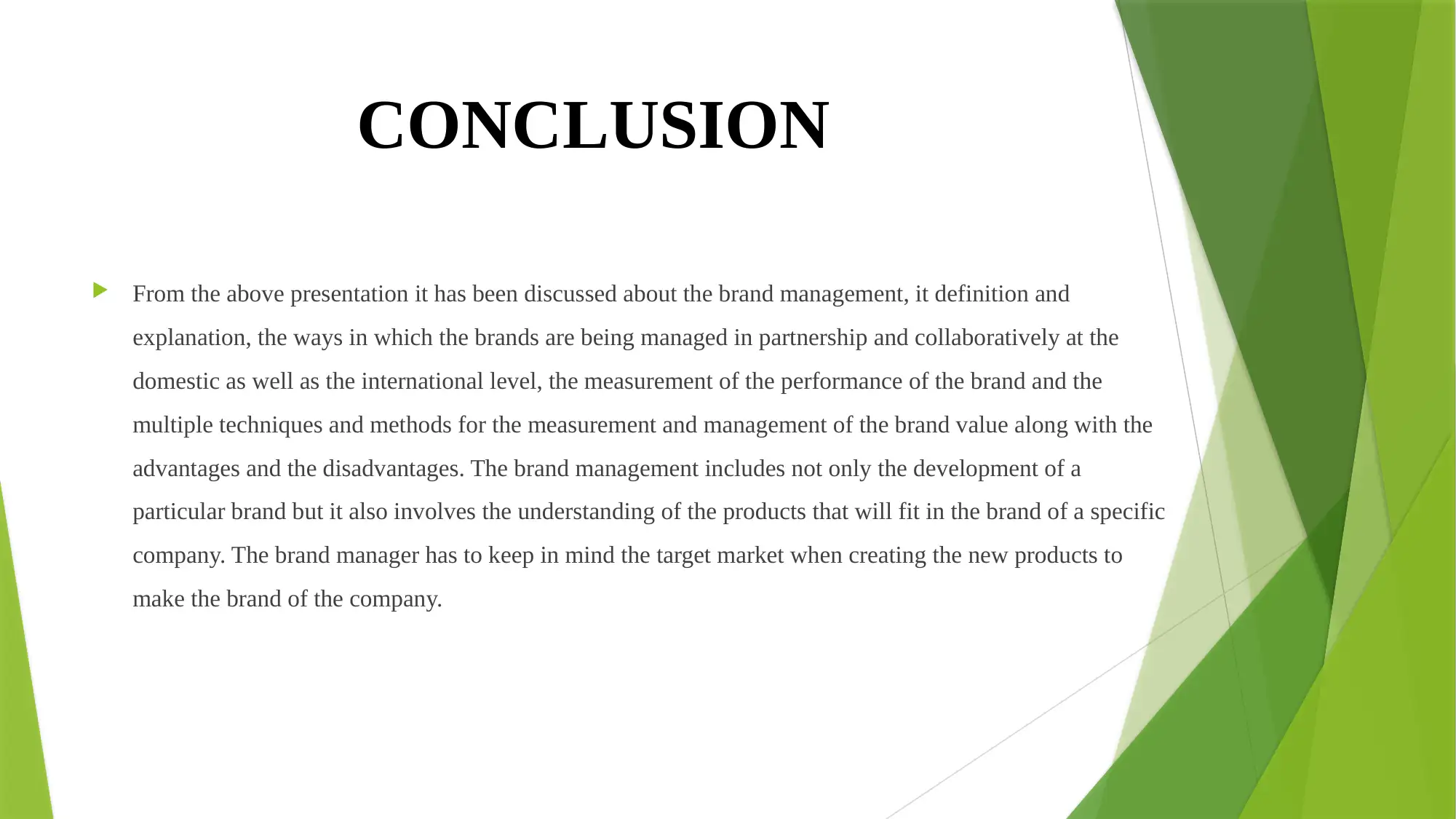
CONCLUSION
From the above presentation it has been discussed about the brand management, it definition and
explanation, the ways in which the brands are being managed in partnership and collaboratively at the
domestic as well as the international level, the measurement of the performance of the brand and the
multiple techniques and methods for the measurement and management of the brand value along with the
advantages and the disadvantages. The brand management includes not only the development of a
particular brand but it also involves the understanding of the products that will fit in the brand of a specific
company. The brand manager has to keep in mind the target market when creating the new products to
make the brand of the company.
From the above presentation it has been discussed about the brand management, it definition and
explanation, the ways in which the brands are being managed in partnership and collaboratively at the
domestic as well as the international level, the measurement of the performance of the brand and the
multiple techniques and methods for the measurement and management of the brand value along with the
advantages and the disadvantages. The brand management includes not only the development of a
particular brand but it also involves the understanding of the products that will fit in the brand of a specific
company. The brand manager has to keep in mind the target market when creating the new products to
make the brand of the company.
Paraphrase This Document
Need a fresh take? Get an instant paraphrase of this document with our AI Paraphraser

REFERENCES
Baumgarth, C., 2018. Brand management and the world of the arts: Collaboration, co-operation, co-creation, and inspiration.
Journal of Product & Brand Management.
Greco, F. and Polli, A., 2020. Emotional Text Mining: Customer profiling in brand management. International Journal of
Information Management.51. p.101934.
Keller, K.L. and Swaminathan, V., 2020. Strategic brand management: Building, measuring, and managing brand equity.
Harlow: Pearson.
Manoli, A.E., 2022. Strategic brand management in and through sport. Journal of Strategic Marketing, pp.1-8.
Marland, A. and DeCillia, B., 2020. Reputation and brand management by political parties: Party vetting of election candidates
in canada. Journal of Nonprofit & Public Sector Marketing.32(4). pp.342-363.
Melewar, T.C. and Skinner, H., 2020. Territorial brand management: Beer, authenticity, and sense of place. Journal of Business
Research.116. pp.680-689.
Miliopoulou, G.Z., 2021. Brand communities, fans or publics? How social media interests and brand management practices
define the rules of engagement. European Journal of Marketing.
Mills, A.J. and Robson, K., 2019. Brand management in the era of fake news: narrative response as a strategy to insulate brand
value. Journal of Product & Brand Management.
Pamfilie, R. and Croitoru, A.G., 2018. Better brand management through design thinking. Amfiteatru Economic.20(12).
pp.1029-1039.
Paul, J., 2019. Masstige model and measure for brand management. European Management Journal.37(3). pp.299-312.
Baumgarth, C., 2018. Brand management and the world of the arts: Collaboration, co-operation, co-creation, and inspiration.
Journal of Product & Brand Management.
Greco, F. and Polli, A., 2020. Emotional Text Mining: Customer profiling in brand management. International Journal of
Information Management.51. p.101934.
Keller, K.L. and Swaminathan, V., 2020. Strategic brand management: Building, measuring, and managing brand equity.
Harlow: Pearson.
Manoli, A.E., 2022. Strategic brand management in and through sport. Journal of Strategic Marketing, pp.1-8.
Marland, A. and DeCillia, B., 2020. Reputation and brand management by political parties: Party vetting of election candidates
in canada. Journal of Nonprofit & Public Sector Marketing.32(4). pp.342-363.
Melewar, T.C. and Skinner, H., 2020. Territorial brand management: Beer, authenticity, and sense of place. Journal of Business
Research.116. pp.680-689.
Miliopoulou, G.Z., 2021. Brand communities, fans or publics? How social media interests and brand management practices
define the rules of engagement. European Journal of Marketing.
Mills, A.J. and Robson, K., 2019. Brand management in the era of fake news: narrative response as a strategy to insulate brand
value. Journal of Product & Brand Management.
Pamfilie, R. and Croitoru, A.G., 2018. Better brand management through design thinking. Amfiteatru Economic.20(12).
pp.1029-1039.
Paul, J., 2019. Masstige model and measure for brand management. European Management Journal.37(3). pp.299-312.
1 out of 14
Related Documents
Your All-in-One AI-Powered Toolkit for Academic Success.
+13062052269
info@desklib.com
Available 24*7 on WhatsApp / Email
![[object Object]](/_next/static/media/star-bottom.7253800d.svg)
Unlock your academic potential
© 2024 | Zucol Services PVT LTD | All rights reserved.



